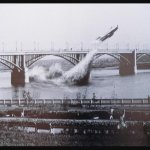
In 1965 an incredible stunt was pulled by a Soviet pilot named Valentin Privalov, who managed to fly his MiG 17 jet fighter under a bridge on the Ob River in Western Siberia.The event was described by witnesses who claim this actually happened, even though the credibility of the photograph depicting the flight has often been debated for being edited.Nevertheless, the story remains. It was a sunny day, on 4th of June 1965, when Privalov flew under the central span of the Communal Bridge in Novosibirsk. The riverbanks were filled with people on vacation and officers from the nearby base, strolling and enjoying the sunshine.All of a sudden, a silver jet in the sky was performing the acrobatic. Everyone was amazed. It was an act of magnificent skill since the jet was never before seen performing a flight with such accuracy.It was reported that Privalov did this on his own initiative, and without any orders whatsoever. The hotshot pilot wanted to pull this stunt for personal glory and to exhibit his flying skills. The crowd gathered on the bridge started to applaud spontaneously, but Privalov’s superiors weren’t so happy. He got a suspension.This almost cost him his career in the Soviet Air Force. He was threatened with disciplinary action, but the Minister of Defense himself, Marshall Rodion Malinovsky, saw the stunt as an advertisement of the military. The people were in awe. The word soon spread all over the USSR, and it soon evolved into a legend.Privalov was sent to the elite Moscow squadron stationed at the Kubinka military airfield. The airfield is home to the aerobatic team “Swifts” and “Russian Knights,” and Privalov joined their ranks.The photograph started circling the internet recently. It found its way through various Russian-language forums to worldwide attention. The origin of the photo is disputable, but it seems that the event depicted on it isn’t.Various reports confirmed that Privalov flew under the Communal Bridge, which is 120 meters wide between its pillars and 30 meters high. He was flying approximately 700 miles per hour.












































































